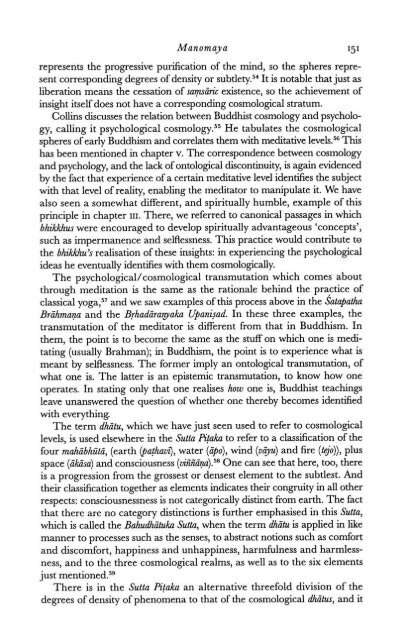Identity and Experience_Hamilton_1996
Identity and Experience_Hamilton_1996
Identity and Experience_Hamilton_1996
You also want an ePaper? Increase the reach of your titles
YUMPU automatically turns print PDFs into web optimized ePapers that Google loves.
Manomaya 151<br />
represents the progressive purification of the mind, so the spheres represent<br />
corresponding degrees of density or subtlety.54 It is notable that just as<br />
liberation means the cessation of sap.siric existence, so the achievement of<br />
insight itself does not have a corresponding cosmological stratum.<br />
Collins discusses the relation between Buddhist cosmology <strong>and</strong> psychology,<br />
calling it psychological cosmology.55 He tabulates the cosmological<br />
spheres of early Buddhism <strong>and</strong> correlates them with meditative levels.56 This<br />
has been mentioned in chapter v. The correspondence between cosmology<br />
<strong>and</strong> psychology, <strong>and</strong> the lack of ontological discontinuity, is again evidenced<br />
by the fact that experience of a certain meditative level identifies the subject<br />
with that level of reality, enabling the meditator to manipulate it. We have<br />
also seen a somewhat different, <strong>and</strong> spiritually humble, example of this<br />
principle in chapter 111. There, we referred to canonical passages in which<br />
bhikkhus were encouraged to develop spiritually advantageous 'concepts',<br />
such as impermanence <strong>and</strong> selflessness. This practice would contribute to<br />
the bhikkhu's realisation of these insights: in experiencing the psychological<br />
ideas he eventually identfies with them cosmologically.<br />
The psychological/cosmological transmutation which comes about<br />
through meditation is the same as the rationale behind the practice of<br />
classical yoga," <strong>and</strong> we saw examples of this process above in the Satapatha<br />
Brihmana <strong>and</strong> the Byhadiranyaka Upani~ad. In these three examples, the<br />
transmutation of the meditator is different from that in Buddhism. In<br />
them, the point is to become the same as the stuff on which one is meditating<br />
(usually Brahman); in Buddhism, the point is to experience what is<br />
meant by selflessness. The former imply an ontological transmutation, of<br />
what one is. The latter is an epistemic transmutation, to know how one<br />
operates. In stating only that one realises how one is, Buddhist teachings<br />
leave unanswered the question of whether one thereby becomes identified<br />
with everything.<br />
The term dhatu, which we have just seen used to refer to cosmological<br />
levels, is used elsewhere in the Sutta maka to refer to a classification of the<br />
four mahibhiiti, (earth (pa~haui), water (ipo), wind (ugu) <strong>and</strong> fire (tejo)), plus<br />
space (ihsa) <strong>and</strong> consciousness (vin"n"ip~).~~ One can see that here, too, there<br />
is a progression from the grossest or densest element to the subtlest. And<br />
their classification together as elements indicates their congruity in all other<br />
respects: consciousnessness is not categorically distinct from earth. The fact<br />
that there are no category distinctions is further emphasised in this Sutta,<br />
which is called the Bahudhituka Sutta, when the term dhitu is applied in like<br />
manner to processes such as the senses, to abstract notions such as comfort<br />
<strong>and</strong> discomfort, happiness <strong>and</strong> unhappiness, harmfulness <strong>and</strong> harmlessness,<br />
<strong>and</strong> to the three cosmological realms, as well as to the six elements<br />
just mentioned.59<br />
There is in the Sutta PiGaka an alternative threefold division of the<br />
degrees of density of phenomena to that of the cosmological dhitus, <strong>and</strong> it


